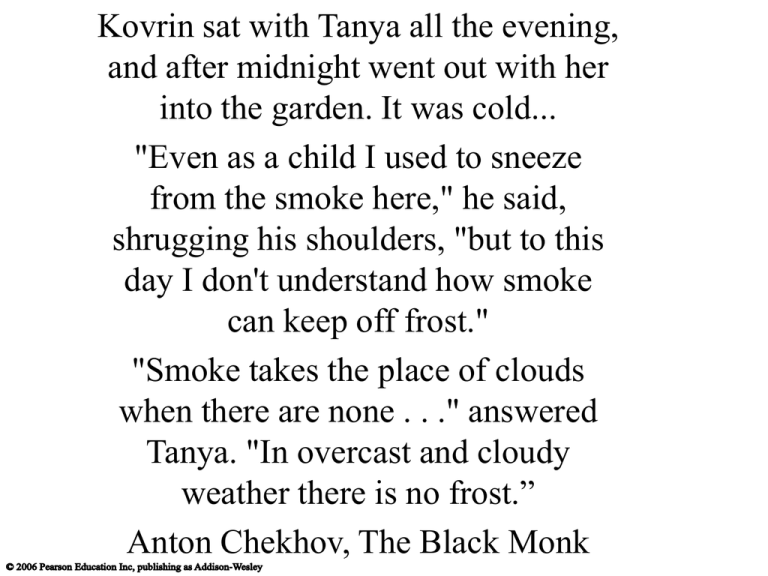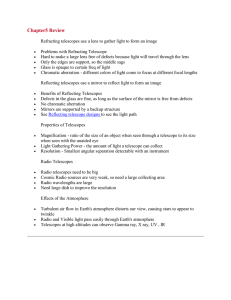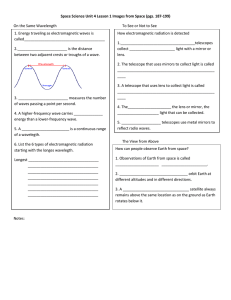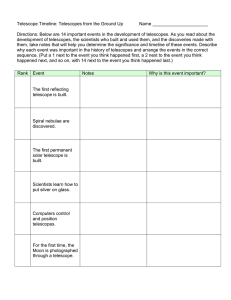Kovrin sat with Tanya all the evening,
advertisement

Kovrin sat with Tanya all the evening, and after midnight went out with her into the garden. It was cold... "Even as a child I used to sneeze from the smoke here," he said, shrugging his shoulders, "but to this day I don't understand how smoke can keep off frost." "Smoke takes the place of clouds when there are none . . ." answered Tanya. "In overcast and cloudy weather there is no frost.” Anton Chekhov, The Black Monk Refraction • Refraction is the bending of light when it passes from one substance into another Example: Refraction at Sunset • Sun appears distorted at sunset because of how light bends in Earth’s atmosphere Angular Resolution • The rings in this image of a star come from interference of light wave. • This limit on angular resolution is known as the diffraction limit Close-up of a star from the Hubble Space Telescope What are the two basic designs of telescopes? • Refracting telescope: Focuses light with lenses • Reflecting telescope: Focuses light with mirrors Refracting Telescope • Refracting telescopes need to be very long, with large, heavy lenses Reflecting Telescope • Reflecting telescopes can have much greater diameters • Most modern telescopes are reflectors Designs for Reflecting Telescopes Mirrors in Reflecting Telescopes Twin Keck telescopes on Mauna Kea in Hawaii Segmented 10-meter mirror of a Keck telescope What do astronomers do with telescopes? • Imaging: Taking pictures of the sky • Spectroscopy: Breaking light into spectra • Timing: Measuring how light output varies with time Light Pollution • Scattering of human-made light in the atmosphere is a growing problem for astronomy Twinkling and Turbulence Star viewed with groundbased telescope Same star viewed with Hubble Space Telescope Turbulent air flow in Earth’s atmosphere distorts our view, causing stars to appear to twinkle Adaptive Optics Without adaptive optics With adaptive optics Rapidly changing the shape of a telescope’s mirror compensates for some of the effects of turbulence Calm, High, Dark, Dry • The best observing sites are atop remote mountains Summit of Mauna Kea, Hawaii Why do we put telescopes into space? How can we observe nonvisible light? • A standard satellite dish is essentially a telescope for observing radio waves Radio Telescopes • A radio telescope is like a giant mirror that reflects radio waves to a focus IR & UV Telescopes SOFIA Spitzer • Infrared and ultraviolet-light telescopes operate like visible-light telescopes but need to be above atmosphere to see all IR and UV wavelengths X-Ray Telescopes • X-ray telescopes also need to be above the atmosphere Chandra X-Ray Telescopes • Focusing of X-rays requires special mirrors • Mirrors are arranged to focus X-ray photons through grazing bounces off the surface Gamma Ray Telescopes • Gamma ray telescopes also need to be in space • Focusing gamma rays is extremely difficult Compton Observatory How can multiple telescopes work together? Interferometry • Interferometery is a technique for linking two or more telescopes so that they have the angular resolution of a single large one Interferometry • Easiest to do with radio telescopes • Now becoming possible with infrared and visible-light telescopes Very Large Array (VLA) Future of Astronomy in Space?


